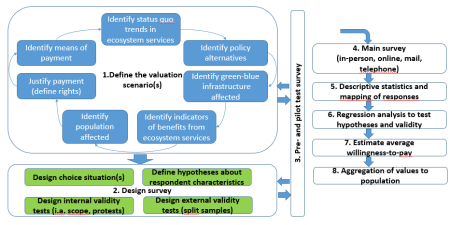
Resource description:
Stated preference valuation is family of techniques which use individual respondents' statements about their preferences to estimate change in utility associated with a proposed increase in quality or quantity of an ecosystem service or bundle of services. Respondents are presented with one or more hypothetical policy or project scenarios that lead to a specified environmental change compared to a baseline situation. The answers respondents give, in the form of monetary amounts, ratings, or other indications of preference, are scaled following an appropriate model of preferences to yield a measure of value of the proposed ecosystem service change.
Author/Contact:
Dr Paula Harrison,
Land Use Group,
Centre for Ecology and Hydrology,
Lancaster Environment Centre,
Library Avenue,
Bailrigg,
Lancs,
LA1 4AP
+44 (0) 1524 595858
Images
Requirements:
- Requires new valuation data, e.g. based on surveys
- Requires working with multidisciplinary researchers and stakeholders
- Licensed software packages and ability to manipulate software required
Advantages:
- Recognised and established approach within environmental economics
- Covers a wide range of ES use and non-use values
- Trade-offs between ES and a few other context characteristics can be evaluated using choice experiments
Constraints:
- Information problems - making it clear which individual or combinations of ecosystems services are included in valuation scenarios.
- Respondents unwillingness to accept trade-offs between ecosystem services and money (e.g. for moral, or cultural reasons)
- Rational choice assumptions and biases - there are a range of potential biases in people's willingness to pay, e.g. their context or role, the prices stated, the order in which parts of ecosystems are valued etc.
Licence:
- Free, no licence
Development stage:
- Full, working product
